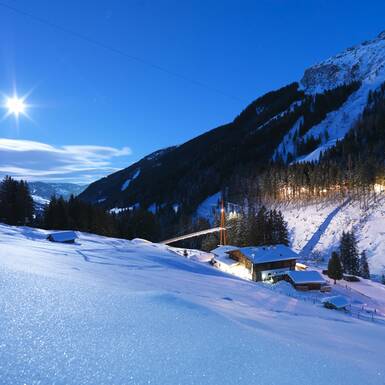- The laid-back 3
3 helpful healing herbs
They are small and unassuming and grow right by the wayside. We often overlook these botanical little helpers because our gaze tends to drift off across the grandiose mountainscape. But in the event of a small ailment incurred during a hike in the mountains of the Glemmtal valley, several of these medicinal herbs can provide some desperately needed relief. Herbal expert Tanja Kees from the Healing Herb Garden at Reiterkogel mountain reveals the 3 best local healing herbs for when you’re out and about.
I find Tanja high up on the Reiterkogel mountain among specimens of “herb Robert” and “lady’s mantle”. Affectionately, she looks after the small flowerbeds right by the Reiteralm mountain pasture and plucks the weeds from between the more useful little plants. Almost caressingly, she strokes over the leaves of the comfrey that’s thriving particularly well this year, and with much pride, she reports about the daisies that are finally growing in their designated flowerbed. I look at the verified practitioner of Traditional European Herbal Medicine somewhat questioningly, for I wasn’t exactly expecting to encounter daisies among the medicinal herbs. Tanja quickly enlightens me, “But of course! The daisy is actually among the three most useful helpers during a hike!” And thus, we’ve already landed right in today’s topic as Tanja begins to explain to me which Alpine herbs one should pay particular attention to when out in the wild.
1 Daisies
Every garden has them — but even high up on the mountain pastures you can still find the little composite plants. “They say if you eat a few daisies on a daily basis you will turn beautiful from the inside out!” claims the herbal expert while I stealthily pluck three particularly large blossoms and quickly stick them in my mouth. They taste a little bit like carrots and so they make an excellent addition to sandwiches or salads. But the daisy is capable of so much more says Tanja. “It can help with bruises, sprains and muscle aches. Its healing properties relieve pains and heal wounds. To do so, just pluck a few flower heads, rub them between your fingers until they turn into mush and apply them onto the bruise. And they even make for a nutritious occasional snack,” she argues as I pick the final treacherous flower petals out of the corner of my mouth. Refreshed and already feeling beautiful on the inside, I ask Tanja for her second healing herb tip. “You’re almost standing on it,” she laughs and points at the English plantain that lines the entire path through the Healing Herb Garden.
2 English plantain
Many know the English plantain as a natural cough suppressant in the form of syrup or as sweets. “Plantago lanceolata” is its Latin name of this disinfecting and germ-inhibiting miracle herb with leaves that looks like lances. “The English plantain is the perfect first aid kit, for example when your hiking boots give you a blister. You take a leaf, use your fingers to crack open the fibres a little, place it on the irritated area, put your sock back over it and keep hiking! The English plantain is also very useful in the case of an insect bite. Simply rub a leaf in between your fingers until it releases its green juice. Rub the juice onto the spot of the bite and relief is provided immediately. Even abrasions after a stumble get the first aid treatment with the English plantain — however, the wound should definitely be cleaned first. Afterwards, just apply a few finely chopped English plantain leaves. The pulp cools, disinfects and removes the burning sensation,” she explains while crushing a leaf between her fingers.
3 Houseleek
Tanja’s next entry in her top 3 favourite medicinal herbs for hikes catches me by surprise — it’s houseleek! I’m quite familiar with the tales, according to which houseleek — also known as liveforever or hen and chicks — was planted on the roofs of houses in order to prevent lightning strikes. Charles the Great even had the custom ordered as a decree. The undemanding succulent is, however, also part of the oldest group of “first aid herbs”, as Tanja explains. She says, “The properties of houseleek are similar to those of aloe vera. During hikes, you really have to pay close attention because houseleek doesn’t grow particularly big on the rocky ground. If your skin starts getting red after a sunburn, or if you get bitten by an insect, just break off one of the thick leaves and press the juice onto the area of the skin that needs treatment. It cools, accelerates healing and provides pain relief.
Meanwhile, the sun is burning bright and strong. Being thirsty, I suggest we make our way back to the Reiteralm mountain pasture hut. Tanja quickly plucks a green stem from the meadow, as well as a couple of leaves, and says, “Here’s a snack — just like common sorrel, French sorrel is a great thirst quencher! You can recognise it quite easily via its shield-shaped leaves. The Silene tastes incredibly refreshing, kind of like peas, and the ground elder is an excellent wild vegetable with a flavour similar to that of parsley.” Chewing on our light snack, we embark upon our way to the Reiteralm mountain pasture hut, where Tanja’s husband Toni is already putting the last touches on fresh regional dishes in the kitchen with herbs from the surrounding meadows.












